
Humpback Whale Migration: A Majestic Journey Across Oceans
We are reader-supported. When you buy through links on our site, we may earn affiliate commission.
The humpback whale migration is one of the most beautiful and intriguing journeys of any marine species on Earth. Their travels take them thousands of miles across the ocean and back, where they search for food and give birth to the next generation.
Humpback whale populations have gone from near extinction to flourishing, where you can now find them worldwide. Of course, to ensure species survival, ongoing conservation efforts are crucial.
Let’s venture into the open seas with these gentle giants as they migrate from cold waters to tropical regions, relying on their innate compass and whale song for survival. We will then explore ways you can do your part to protect this species.
Why Do Humpback Whales Migrate?
The humpback whale migration can be summed up in two words: Feeding and breeding. Each year, humpback whales traverse thousands of miles to bustling feeding grounds in colder waters with an array of krill — a critical food source for the whales.
The whales eat as much krill and small fish as possible — which helps them generate blubber — to last them during the winter. As the seasons change, krill begin disappearing while ice caps form — and the humpback whales travel to tropical areas to breed.
Female humpback whales give birth to one calf every one to three years after an 11.5-month gestational period. Each calf is about 13–16 long feet and stays alongside its mother for one year.
Humpback whales rarely feed during migration and breeding. Instead, they rely on their fat stores to sustain them until they venture back to their feeding grounds the following spring, summer and fall.
Where Does the Humpback Whale Migration Take You?
As far as scientists know, the humpback whale migration is the longest mammal migration on record. Populations will swim as far as 5,000 miles between their feeding and breeding spots. The whales traveling between Alaska and Hawaii can cover the 3,000-mile distance in 36 days.
You can find humpback whales around the world, with four distinct populations in the following regions:
- Mexico population: Feeds from California to Alaska and breeds along the Pacific coast of Mexico
- Hawaii population: Feeds near Alaska, the Bering Sea, and Northern British Columbia and breeds around the Hawaiian Islands
- Central American population: Feeds along the western U.S. coast and Southern British Columbia and breeds in the Pacific coast — Panama, Guatemala, Honduras, Costa Rica, and others
- Western North Pacific population: Feeds in the West Bering Sea, Aleutian Islands, and the Russian coast and breeds in Okinawa, Japan, and the Phillippines
Navigating the Seas
The humpback whale migration is only made possible by their uncanny ability to navigate the seas safely.
A study from the University of Canterbury tagged and monitored 16 humpback whales during their annual migration from the North to the South Pacific. To their surprise, the whales traveled over 600 miles while veering less than one degree off their path.
Unlike other migratory mammals that use an internal navigation system through the sun’s position or the Earth’s magnetic field, this isn’t the case for humpback whales. For one thing, the magnetic field bears too much variation, and they cannot go by solar navigation underwater. Instead, humpback whales rely on their exceedingly slow movements to follow the straightforward path.
This is impressive, considering how the humpback whale swims through some of the most volatile water. Most would venture off the beaten course.
The Secrets of Humpback Whale Songs
Male humpback whales have one of the most pronounced calls, possibly to attract mates on their way to breeding grounds or communicate with young calves.
Humpback whale songs can reach several kilometers underwater. Most calls are 30 minutes long, which they’ve been known to repeat for hours.
Although little is known about humpback whale calls, scientists know they transcommunicate songs to other populations. Even more intriguing, humpback whales have different dialects based on where they come from. Calves must learn the dialect since they aren’t born knowing it.
Marine biologist Ellen Garland was surprised to hear humpback whales passing songs onto whales in French Polynesia. Those whales then passed it along to the whales in Ecuador. A humpback whale song can travel thousands of miles in only a few years.
Conserving Humpback Whales
There’s been much to celebrate about humpback whales in recent years. After being one of the first species conserved under the Endangered Species Conservation Act in 1973, their populations have significantly returned. They also maintain protection under the Marine Mammal Protection Act.
The U.S. Congress established the Hawaiian Islands Humpback Whale National Marine Sanctuary in 1992 to protect populations around Hawaii.
The National Oceanic and Atmospheric Administration also opened two humpback whale sanctuaries — the Stellwagen Bank National Marine Sanctuary and the Santuario de Mamiferos Marinos de la República Dominicana — off the coasts of Massachusetts and the Dominican Republic. Nearly 900 humpback whales swim to and from each location annually.
These global conservation initiatives have brought humpback whale numbers from 10,000–15,000 to over 80,000 today.
What Can You Do to Protect Humpback Whales?
Although the humpback whale population is doing great, they are still vulnerable to human activity and other natural perils. Individual efforts might seem null, but there is much you can do to help protect them, especially in the following ways:
- Pick up trash on the beach and remove nets and other fishing gear to prevent entanglement.
- Follow boating restrictions to avoid collisions with humpback whales in high-traffic areas.
- Reduce your carbon footprint and adopt a greener lifestyle.
- Always purchase sustainable seafood to avoid straining their food supply.
- Support global conservation efforts in protecting the humpback whale migration.
- Support scientific research on humpback whales and participate in citizen science to help monitor their movements.
- Share your knowledge about humpback whales with everyone you know.
Whales are more important to the planet than you think. The humpback whale migration, in particular, spreads fecal matter for phytoplankton production. Phytoplankton absorbs 40% of carbon dioxide and produces over 50% of the oxygen we breathe.
The Most Spectacular Voyage Across the Seas
The humpback whale migration is breathtaking for several reasons. These creatures are as resilient as they are majestic. While the species numbers are on an upward trend, we want to keep it that way. Therefore, it is essential to follow guidelines and restrictions aimed at protecting marine wildlife.
Share on
Like what you read? Join other Environment.co readers!
Get the latest updates on our planet by subscribing to the Environment.co newsletter!
About the author
Rachel Lark
Rachel serves as the Assistant Editor of Environment.co. A true foodie and activist at heart, she loves covering topics ranging from veganism to off grid living.





